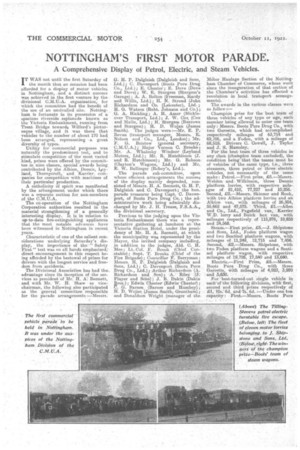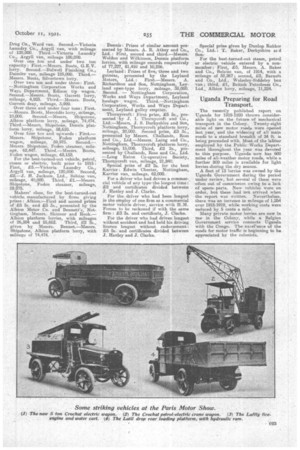NOTTINGHAM'S FIRST MOTOR PARADE.
Page 12

Page 13

If you've noticed an error in this article please click here to report it so we can fix it.
A Comprehensive Display of Petrol, Electric, and Steam Vehicles.
IT WAS not until the first Saturday of the month that an occasion had been afforded for a display of motor vehicles in Nottingham, .and a distinct success was achieved in the first venture by the divisional C.M.U.A. organization, for which the committee. had the benefit of the use of an unrivalled site. Notting. ham is fortunate in its possession of a spacious riverside esplanade known as the Victoria Embankment, running from Trent Bridge towards Wilford's picturesque village, and it was there that vehicles to the number of about 170 had been arranged, representing a great" diversity of types.
Utility for commercial purposes was naturally the predominant test, and to S timul a te competition of the most varied kind, prizes were offered by the committee in nine classes, special awards being contributed by the Albion, Dennis, Leyland, Thernycroft, and Karrier_ cornpause for competition with machines of their particular production.
A catholicity of spirit was manifested by the arlangement under which there was a separate section for non-members of the C.M.U.A.
The co-operation of the Nottingham Corporation authorities resulted in the material strengthening of a generally interesting display. It is in relation to. ap-to-dato fire-extinguishing appliances that the most notable advances have been witnessed in Nottingham in recent years. Characteristic of one of the salient considerations underlying Saturday's display, the importance of the -" Safety First" test was on all hands emphasized; direct encouragement in this respect being afforded by the bestowal of prizes for drivers with the longest service and freedom from accidents.
The Divisional Association has had theadvantage since its inception of the services as president•of Mr. H. A: Bennett, and With Mr. W. H. Shaw as vicechairman, the following also participated as the general committee responsible for the parade arrangements:—Messrs. G. H. P. Didgleish (Dalgleish and Sons, Ltd.); C. Davenport (Boots Pure • Drug Co., Ltd.); E. Chester; E. Dove (Dove and Dove); W. B. Sturgess (Sturgess's Garage); A. A. Bolton (Freeman, Hardy and Willis, Ltd.); H. N. Stroud (John Richardson and Co. (Leicester), Ltd.; H. G. Watson (Rout. Johnson and Co.); G. A. Hiekiing; A. H. Amor (Mickleover Transport, Ltd.); J. W. Cox, (Cox and Malin, Ltd.); H. Sturgess (Burrows and Sturgess); H. D. Wojart (James Smith). The judges were :—Mr. E. P. Bevan (transport manager, Messrs. E. Nelson and Co., Ltd., London); Mr. F. G. Bristow (general secretary, C.M.U.A.); Major Vernon C. Brooke; Mr. A. Whalesby Windsor(Leyland Motors, Ltd.); Mr. R. Hutchinson (J. and R. Hutchinson); Mr. G. Robson (Clayton's Wagons, Ltd.); and Mr. E. W. Ballinger (Robey's, Ltd.).
The parade sub-committee, upon whose efficient arrangements the success of the display mainly depended, consisted of Messrs. ii. A. Bennett, G. H. P. Dalgleish and C. Davenport; the hon. parade treasurer being Capt. C. Davenport, of Boots Pure Drug Co.; the administrative work being admirablydischarged by Mr. J. H. Trease, F.S..A.A., the divisional secretary.
Previous to the judging upon the Victoria Embankment there was a representative gathering at luncheon at the Victoria Station Hotel, under the presidency of Mr. EL A. Bennett, at which the municipality wa-s represented by the Mayor, the invited company including, in addition to the judges, Ald. C. H. Mee; Lt.-Col: F. Brook (Chief. Constable); Supt. T. Breaks (Chief of the Fire Brigade); Councillor F. Berryman; Messrs. H. P. Dalgleish (Dalgleish and Sons, Ltd.); C. Davenport (Roots Pure Drug Co., Ltd.); Arthur Richardson (A. Richardson and Son); A. Riley :(J: Player and Sons); J. B. Dakin (Dakin Duos.); Edviin Chester (Edwin Chester') ; C. G. Barnes_ (Barnes and Hainbey);
H. D. Wojan. (James Smith, Granthain); and Donaldson Wright (manager of the Mdlor Haulage Section of the Nottingham Chamber of Commerce, whose work since the inauguration of that section of the Chamber's activities has effected a revolution in local transport arrangements).
The awards in the various classes were as follow e
ChampiOn prize for the best team of three vehicles of any type or age, each member being allowed to enter one team only: Messrs. Boots Pure Drug Co. with two Garretts, which had accomplished respectively mileagesof 63,714 and 69,786, and a Foden' with a mileage of 68,518. .Drivers C. Cowell, J. • Taylor, and J. 8. Barnsley.
For the best team of three vehicles in any class (chainpion team excluded), the condition being that the teams must be of vehicles of the same type, i.e., three steamers, three petrol or three electric vehicles, not necessarily of the same make: Petrol.—First prize, 5.—Messrs. Weldon andWilkinson, .three Dennis platform lorries, with respective mileages of 81,410, 77,227 and 10,256. 'Second, £2.—Messrs. Skinner and Rook, with two Albion platform lorries• and an Albion van, with mileages. of 26,504, 55,662 and 47,575.' Third, M.—Allen and Co., Ltd., Pagefielsl van, Karrier W.D. lorry and Buick box van, with mileages respectively of 115,876, 19,858 and .24,568.
Steam.—First prize, Shipstone and Sons, Ltd., Foden platform wagon and two Sentinel platform wagons, with .mileages of 11,249, 12,715 and 7,456. Second, -E-2.—Messrs. Shipstone, with two Foclen platform wagons and a Sentinel platform wagon, with respective mileages. of .19,728, 17,540 and 13,680.
Electric,—.First Prize, L6.—Messrs. Boots Pure Drug Ca., with three (hrretts, with Mileages of 4,923, 3,999 _ and 3B30. : • • . .
-For 'best-turned-out single vehicle in each:of-the fallOwitig divisions, with first, second and third prizes respectively of 21, 10s ."6d. and 7s. 6d. :—Under one ton capacity : First.—Messrs. Boots Pura Drug Co.' Ward van. Second.—Victoria Laundry Co., Argyll van, with mileage of 120,000. Third.—Victoria Laundry Co., Argyll van, mileage 100,000. Over one ton and undertwo ton capacity First.—Messrs. Boots, G.E.V. lorry. Second.—Bulwell Finishing Co., Daimler van, mileage 125,000. Third.— Messrs. Boots, Silvertown lorry.
Over two toss and under three: First. —Nottingham Corporation Works and Ways Department, Edison tip wagon. Second.—Messrs. Boots, Garrett lorry, mileage, 4,923. Third.—Messrs. Boots, Garrett dray, mileage, 3,999. Over three and under four tons; First. —Messrs. Boots, Mercedes lorry, mileage, 10,000. Second.—Messrs. Shipstone, _Albion platform lorry, .mileage, 74,474. Third.—Messrs. Shipstone, Dennis platform lorry, mileage, 58,610. Over four ton and upwards : First.— Messrs. Shipstone, Foden platform wagon, mileage, 59,975. Second.— Messrs. Ships-tone, Foden steamer, mileage, 62,447. Third.—Messrs. loots, Foden wagon, mileage, 68,158.
For the best-turned-out vehicle, petrol, steam or electric, built prior to 1915 First, £5.—Victoria Laundry Co., Argyll van, mileage, 120,000. Second, £2.—J. H. Jackson, Ltd., Belsize van, mileage, 40,000. Third, £1.—Messrs, Shipstone, Foden steamer, mileage, 59,975.
Makers' class, for the best-turned-out vehicle, manufactured by firms giving prizes : Albion.----First and second prizes of£5 5s. and 23 3s., presented by the Albion Motor Co. and Bennett's; Nottingham, Messrs. Skinner and Rook.— Albion platform lorries, with mileages of 26,504 and 55,662. Third, 22 2s., given by Messrs. Bennet. —Messrs. .Shipstone, Albion platform lorry, with mileage of 74,474.
Dennis: Prizes of similar amountpresented by Messrs. A. R. Atkey and Co., Ltd. : First, second and third.—Messrs. Weldon and Wilkinson, Dennis platform lorries, with mileage records respectively of 77,227, 81,410 and 10,256.
Leyland: Prizes of five, threeand two guineas, presented by the Leyland Motors, Ltd. : First—Messrs. A. Richardson and Son, Nottingham, Leyland open-type lorry, mileage, 35,000. Second. — Nottingham Corporation, Works and Ways Department, Leyland haulage wagon. Third.—Nottingham Corporation, Works and Ways Department, Leyland gultey emptier.
Thornycroft: First prize, £5 5s., presented by J. I. Thornycroft and Co., Ltd:—Messrs, J. S. Derbyshire and Son, Nottingham, Thornycroft platform lorry, mileage, 20,000. Second prize, 23 38., presented by Messrs. Challands, Ross and Co.., Ltd.—Messrs.. Laing and Co., Nottingham Thornycroft platform lorry, mileage, 15:000. Third, £2 2s., presented by Challands, Ross and Co., Ltd. —Long Eaton Co-operative Society, Thornycroft van, mileage, 21,840.
Special prize of 22 2s. for the best Karrier : Edwin Chester, Nottingham, Karrier van, mileage, 62,000.
For a driver who had driven a commercial vehicle of any type-the longest. time: 22 and certificates divided between J. Hanley and J. Clarke.
For the . driver who had been longest in the employ of one firm as a commercial motor vehicle driver, service with ELM. Forces to be reckoned if with the same firm : 23 3s, and certificate, J. Clarke.
For the driver who had driven longest without accident and had held his driving licence longest without endorsement: £5 5s. and certificates divided between J. Hanley and J. Clarke.
Special prize given by Dunlop Rubber Co., Ltd.: T. Baker, Derbyshire ard Son: For the best-turned-out steam, petrol or electric vehicle entered by a nonmember: First, £5, Messrs. A. Baker and Co., Belsize van, of 1914, with a mileage of 32,267; second, £2, Barnett and Co., Ltd., Wolseley-Siddeley box van; third, £1, British Petroleum Co., Ltd., Albion lorry, mileage, '11,224.
Uganda Preparing for Road Transport.
The recently published report; on Uganda for 1919-1920 throws considerable light on the future of mechanical transport in the Colony. Twenty-eight miles of new motor roads were opened last year, and the widening of all main roads to a standard breadth of 24 ft. is being proceeded with. Most of the labour employed by the Public Works Department throughout the year was devoted to this purpose. Uganda now has 600 miles of all-weather motor roads, while a further 800 miles is available for light lorries-during the dry season. A fleet of 12 lorries was owned by the Uganda Government during the period under review, but several of these were often out of commission owing to a lack of spare; parts. New vehicles were on order, but these had -not arrived when the report was written. Nevertheless, there was an increase in mileage of 1,254 over 1918-1919, while working costs were reduced by 5 cents a mile.
Many private motor lorries are now in use in the Colony, while a Belgian Government service connects Uganda with the Congo. The ekcerence of the roads for motor traffic is beginning to be appreciated by the colonists.




















































